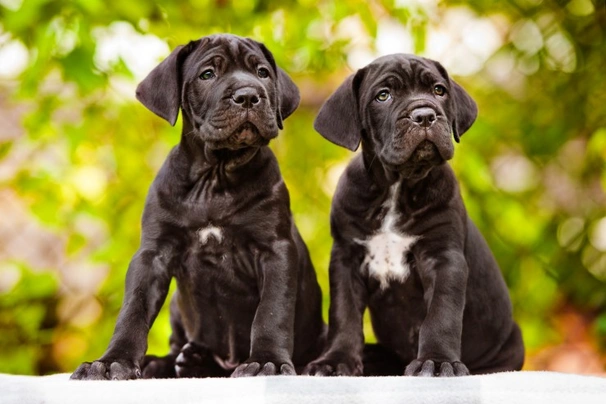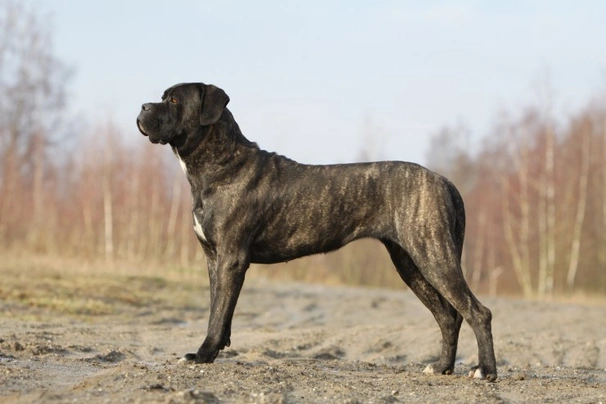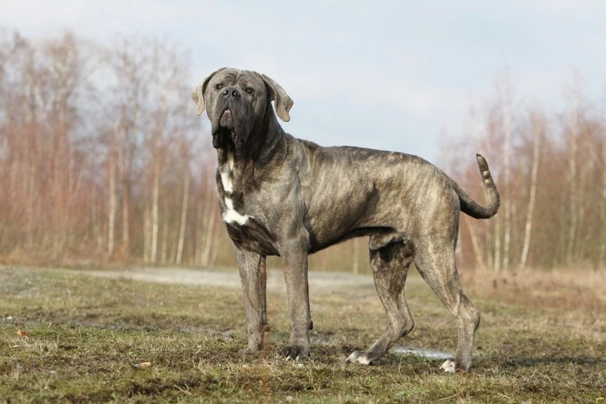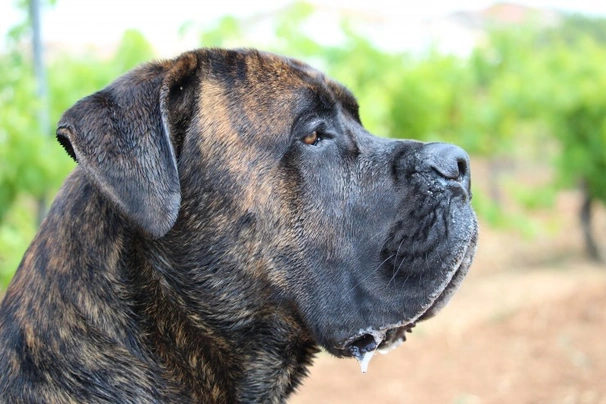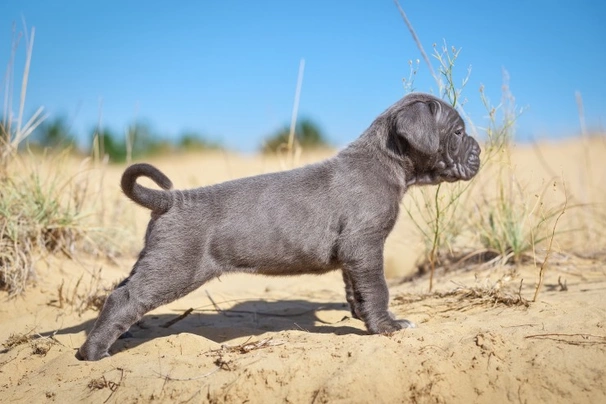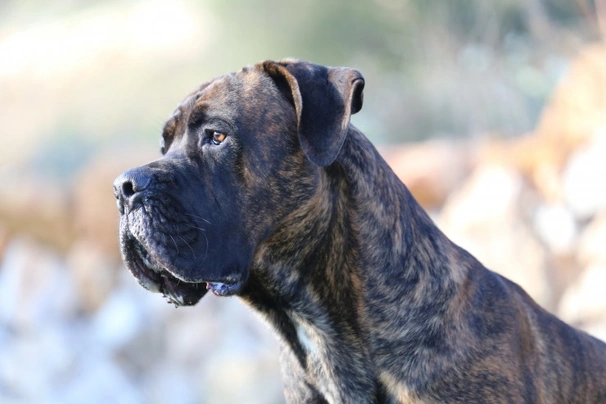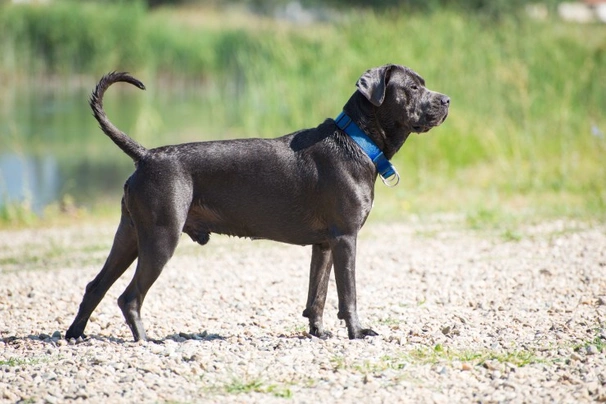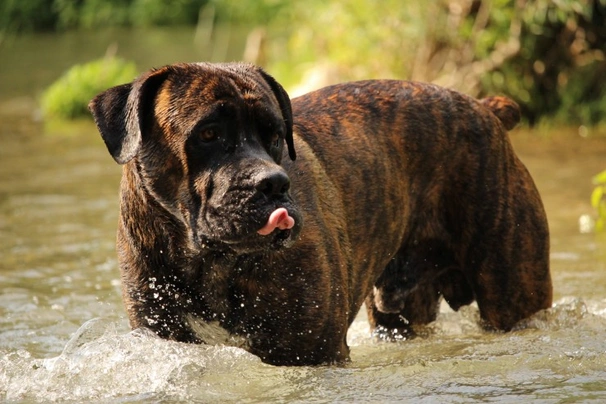Cane Corso
Pros
Cons
Introduction of the Cane Corso
The Cane Corso is an impressive looking mastiff-type dog that's native to Italy where they were originally bred to guard herd and hunt although they were also highly prized as companion dogs too. They are still a very popular choice in their native Italy thanks to their impressive looks and kind loyal natures but less popular here in the UK simply because the breed is less known in this part of the world. The breed is not recognised by The Kennel Club (October 2017) but these impressive dogs are recognised by the American Kennel Club. Anyone wanting to share a home with a Cane Corso would have to agree to go on a waiting list because very few puppies are available every year.
History of the Cane Corso
The Cane Corso is a descendant of ancient breeds native to Italy both of which were mastiff-type breeds that in turn were descendants of the canis Pugnaces which was a dog that was around in ancient Roman times. In fact the Neapolitan Mastiff as well as the Cane Corso are descendants of the canis Pugnaces a war dog that boasted a renowned reputation for being strong courageous and loyal. The Cane Corso is a lighter type of mastiff and a very adept hunter and working dog whereas the Neapolitan was that much heavier and stockier.
There are records of the Cane Corso that go back to as early as 1137 AD and their name describes a lighter type of Molossian dog and one that was robust and sturdy. With this said the breed has been known by other names which includes Dogo di Puglia and they were so highly prized that they were often used to describe men who were "proud with strong attitudes". In ancient Roman times. the Cane Corso accompanied legions in battle and on their forays into foreign lands which included Britain.
It was in Britain that the Romans found native dogs known as pugnaces Britanniae which they took back to Italy with them and which they crossed with their own native dogs which are thought to be responsible for the undershot jaw of the Cane Corso.
The Cane Corso faced extinction by the 1970's with dogs only being found in the remotest areas of the land which included the most southern regions of Italy where locals still used and trained their dogs to hunt and work as farm dogs. The breed was saved by Sig Bonnetti who was an enthusiast of Molosser type dogs and who was keen to save an ancient "Pugliese" breed. Together with a student by the name of Stefano Gandolfi he set up a centre in Mantova to save the breed from vanishing altogether. They used a black dog called Dauno which was crossed with a female called Tipsi and they produced the first important litter for the recovery of the breed in modern times. By 1983 a breed club was established called the Society Amatori Cane Corso and the breed was officially recognised by the ENCI. Two years later in 1996 the Cane Corso was given FCI recognition.
Breed numbers started to rise although some people believe the dogs we see today are not like the dogs of yesterday being that much heavier and larger today than they were in the past.The Cane Corso was finally recognised as a breed in its own right by the UKC in 2008 but as of June 2016 they have not been recognised by The Kennel Club here in the UK. These large and impressive dogs are a very popular choice in America and have gained a big fan base in the UK thanks to their handsome looks and loyal intelligent natures.
Interesting facts about the breed
- Is the Cane Corso a vulnerable breed? No they are among some of the more popular breeds in the UK and elsewhere in the world too
- The Cane Corso shares an interesting ancestry with the Neapolitan Mastiff
- Traditionally the Cane Corso has always had tails docked a practice that has been going on throughout time. The reason dog’s tails were docked was to prevent them from being damaged when dogs were working. In 1993 that a law was passed preventing anyone other than a vet from carrying out the procedure but this was further changed when The Animal Health and Welfare Act (Scotland) came into effect in 2006 which invoked a total ban on tail docking unless for medical reasons. In other parts of the UK the Animal Welfare Act came into effect in April 2007 which meant that dog's tails could no longer be docked unless they fell into the category of a specific "working" dog or for medical reasons which must be authorised by a qualified vet
- The Cane Corso is a natural watchdog that does not need any extra training to guard and protect which could make a dog more aggressive and dominant by nature
Appearance of the Cane Corso
Height at the withers: Males 62 - 70 cm Females 58 - 66 cm
Average Weight: Males 40 - 45 kg Females 40 - 45 kg
The Cane Corso is a large dog and one that boasts a great deal of muscle tone which adds to their very powerful and athletic appearance. They are quite imposing but at the same time they are well proportioned even though they have large heads typical of Mastiff-type breeds. Their skulls are broad but get flatter just behind a dog's forehead and towards the back of their heads making them brachycephalic. There is quite a deep furrow at the front of a dog's head and their stop is well defined.
When seen from the front a dog's skull is slightly curved and wide whereas when seen from the side it appears to be an irregular curve. Muzzles are short and deep yet very powerful looking being just as wide as they are long with dog's having a level bridge to their noses. Their upper lips hang down so they cover the lower jaw. The Cane Corso has a strong slightly undershot powerful jaw. Their noses are black and large with dogs having open nostrils.
Eyes are oval medium in size and set so dogs look directly forward. These dogs always have a keen alert and intelligent look about their eyes. Their ears are medium in size triangular-shaped and droop down being set wide apart on a dog's head. Necks are very muscular and strong being the same length as a dog's head. Shoulders are well-muscled and long being set obliquely with dogs boasting powerful straight front legs.
A Cane Corso's body is longer than these dogs are tall but they are compact and sturdy with dogs having well developed chests that reach to their elbows. Withers are nicely pronounced and are higher than the croup. Their backs are firm and very well-muscled with dogs having short powerful loins and their croups is wide long and sloping. Their back legs are powerful with dogs having strong and well developed lower thighs. They have cat-like feet with their back feet being less compact than their front ones. Tails are set quite high and are thicker at the root which dogs carry high.
When it comes to their coat the Cane Corso has a short very dense and glossy coat with a slight undercoat. They come in a variety of colours which includes the following:
- Black
- Plumb-grey
- Slate
- Light grey
- Light fawn
- Deer fawn
- Dark fawn
- Tubby - very distinct stripes on various shades of fawn and grey
Dogs with fawn and tubby coats have grey or black masks which should never go further up than a dog's eye line. Dogs can have a small patch of white on their chests throats chin and on the tips of their feet as well as on the rise of their noses.
Dogs often have a little white spot on their chests and white on their toes as well as on the bridge of their noses.
Gait/movement
When a Cane Corso moves they do so with an easy flowing gait that gives the appearance of a steady amble. They take long steps which stretch out when a dog is trotting and at the gallop.
Faults
Any exaggerations in a dog's skull or muzzle would be deemed faults and the severity of the fault would be judged on how much it affects a dog's overall health and wellbeing as well as their ability to perform. This includes Cane Corsos with exaggerated overshot mouths and pronounced undershot jaws. Males should have both testicles fully descended into their scrotums.
Temperament of the Cane Corso
The Cane Corso is known to be reliable trustworthy and loyal and they form strong bonds with their families becoming totally devoted to them. They boast having a strong protective instinct although they are gentle and affectionate by nature too. They tend to be a little aloof and wary when they are around people they do not know but would rarely show any sort of aggression towards a stranger preferring to keep their distance and just let their owners know they are around. Once they get to know someone they are generally fine around them. It is worth noting that a Cane Corso matures slowly and never really reach full maturity until they are around 4 years old.
They are not known to have a high prey drive preferring to stay within the boundaries of their own homes and around their owners. One thing that is worth bearing in mind is that the Cane Corso has quite a high pain threshold which means that even when they are injured or in any sort of pain it can be quite hard for owners to spot there is a problem.
They are not the best choice for first time owners because they are the sort of dog that needs to be trained and handled by someone who is familiar with the needs of the breed or similar type of intelligent large dog. Without the right sort of socialisation and training the Cane Corso can become an unruly dog that's hard to manage and live with. These dogs are never happier than when they know who is the boss in a household and will happily accept their place in the "pack" as long as they have been well handled from the word go.
The Cane Corso tends to form a strong bond with one person in a household although they are always devoted to everyone in the home. They are a good choice for people who lead active outdoor lives and who live in a country environment and who boast large secure back gardens. They are a good choice for people where one person is usually around when everyone else is out of the house because these large dogs thrive on human company and do not do well if left on their own for longer periods of time.
If they are left to their own devices for any length of time they quickly get bored and this can lead to dogs developing all sorts of unwanted behavioural issues which includes being destructive around the home. They are not a good choice for people who lead more sedentary lives and who live in apartments.
Although lovely dogs to have in a home environment it's worth noting that because they are brachycephalic the Cane Corso does have a tendency to snore quite loudly and they do drool quite a bit. They are also known to pass wind a lot which when paired to the fact they shed considerably during the Spring and then again in the Autumn means they are not the best choice for people who are very house proud.
Another thing to bear in mind is that a Cane Corso must be taught that being left on their own is not a problem and the best way of doing this is to start leaving them to their own devices for short periods of time. If a dog stresses out and becomes destructive around the home they are not ready to be left which means starting all over again and leaving them for a few minutes before returning all the while remaining very calm and to gradually build up the time over a few days. It must be said that some Cane Corsos never accept being on their own which is why they are better suited to people who work from home or in households where one person stays at home when everyone else is out.
Are they a good choice for first time owners?
The Cane Corso is not a good choice for first time dog owners because they need to be handled and trained by people familiar with the specific needs of such a large and intelligent dog. Because they can show a more dominant side to their natures if not well trained and socialised a Corso might get the better of anyone who is not used to this type of mastiff breed.
What about prey drive?
The Cane Corso was trained to hunt and to guard but they are not known to have high prey drives and providing they have been well socialised from a young enough age they usually tolerate being around other animals. With this said care should always be taken when walking a dog off the lead through the countryside and other areas where they might meet wildlife and livestock just to be on the safe side.
What about playfulness?
The Cane Corso is a serious dog although when they are puppies like all puppies they are boisterous and playful. They thrive in a home environment and love nothing more than to be involved in everything that goes on around them which includes playing interactive games with their families and the kids.
What about adaptability?
The Cane Corso needs enough space to express themselves and being such large dogs they benefit from being able to run free in a secure back garden as often as possible. As such they are not adaptable and would not be happy living in an apartment setting.
What about separation anxiety?
As previously mentioned a Cane Corso forms strong ties with an owner and dogs are never very happy when they find themselves left on their own for even shorter periods of time which is why they are better suited to households where one person stays at home when everyone else is out. A Cane Corso would show signs of suffering from separation anxiety which can lead to them being destructive around the home which is a dog's way of relieving any stress they are feeling and a way to keep themselves entertained and being such large and powerful dogs the damage they can do is often quite dramatic not to mention the risk there is of them injuring themselves in the process too.
What about excessive barking?
The Cane Corso is not known to be a "barker" although any dog that's unhappy or left on their own for any length of time might start barking incessantly as a way of getting attention. With this said a dog would quickly let an owner know when something they don’t like is going on in their environment but would not generally bark for no reason.
Do Cane Corsos like water?
Some Cane Corsos like swimming and will take to the water whenever they can more especially when the weather is hot. However if anyone who owns a dog that does not like water should never force them to go in because it would just end up scaring them. With this said care should always be taken when walking a Cane Corso off the lead anywhere near more dangerous watercourses just in case a dog decides to leap in and then needs rescuing bearing in mind that they are a brachycephalic breed and dogs with shorter muzzles often have trouble breathing.
Are Cane Corsos good watchdogs?
The Cane Corso is a natural watchdog which is a trait that is deeply embedded in a dog's psyche. This together with their need to "protect" makes them formidable and impressive watchdogs that would put any wrongdoer from coming onto a property they live on.
Intelligence / Trainability of the Cane Corso
The Cane Corso is very intelligent and they like nothing better than to please their owners as such in the right hands and with the correct amount of socialisation they are easy to train and easy to handle. However these large smart dogs need to know their place in the "pack" and who to look to for direction and guidance to be truly well-rounded obedient dogs without this a dog would quickly take on a more dominant role making them a lot harder to live with.
It cannot be stressed enough the importance of early socialisation with these dogs and their training has to start early and be consistent throughout their lives to prevent them from showing a more dominant side to their natures. This could lead to a Cane Corso becoming unruly and therefore unmanageable to the point of being quite dangerous. However in the right hands and with the correct amount of training and exercise the Cane Corso grows up to be an obedient mature dog that's a pleasure to have around.
Puppies must be taught the limits boundaries and ground rules right from the word go so they understand what an owner expects of them. A Corso puppy may be cute but they are also intelligent quick-witted and strong which means without the right sort of handling and direction they could quickly become unruly and wilful. The first commands a puppy must be taught are as follows:
- Come
- Sit
- Stay
- Quiet
- Leave it
- Down
- Bed
Children and other
When Corsos are well socialised from a young age and puppies grow up with children in a household they are known to get on well together and this includes where there are other animals in the home too. However because of their sheer size any interaction between very young children and dogs is best supervised to make sure playtime never gets too boisterous which could lead to a child being frightened or in a worst-case scenario injured in any way. Corsos are known to be a little over protective at times as such extra care should be taken when children have any friends over to play.
When it comes to other dogs well socialised Corsos are generally good around them but care should be taken when they meet any new dogs to be on the safe side because they are known to be confrontational and will not back down if they feel threatened by another dog in any way. Cane Corsos are not high prey drive dogs and as such they generally tolerate other animals. However if a cat or other animal decides to run away from them a Cane Corso would think nothing of chasing them and if they do catch them the results could be disastrous for the fleeing animal.
Health of the Cane Corso
The average life expectancy of a Cane Corso is between 10 and 11 years when properly cared for and fed an appropriate good quality diet to suit their ages.
Like so many other breeds the Cane Corso is known to suffer from a few hereditary health issues which are worth knowing about if you are planning share your home with one of these large and impressive dogs. The conditions that seem to affect the breed the most include the following:
- Hip dysplasia - Stud dogs should be hip scored
- Elbow dysplasia - stud dogs should be elbow tested
- Cherry eye
- Ectropion ( Eyelids Roll Outwards )
- Entropion ( Eyelids Folding Inwards )
- Cardiomyopathy - a heart problem
- Epilepsy
- Wobbler's syndrome
- Thyroid issues
- Demodectic mange - a skin disorder
- Allergies
- Bloat
- Cruciate ligament issues
Because the Cane Corso has such a short nose being a brachycephalic breed they are sensitive to heat so care must be taken during hotter weather. They are also known to have a sensitivity to any sort of anaesthetic and sedatives.
More about demodectic mange
Demodectic mange is a skin problem that is seen in the breed and it is caused by demodex mites that lives on a dog's hair follicles. All dogs have these mites but the problem flares up when their numbers are too high which causes skin irritation. The condition is an inflammatory disorder which if left untreated can result in skin lesions as well as immune system issues and loss of hair. A vet would carry out a urine test to establish the cause and whether it is a metabolic system issue.
More about hip scoring and elbow testing
Cane Corsos that are to be used for breeding purposes should have their hip scored and be elbow tested which can be carried out by several companies in the UK which includes the British Veterinary Association amongst others.
What about vaccinations?
Cane Corso puppies would have been given their initial vaccinations before being sold but it is up to their new owners to make sure they have their follow-up shots in a timely manner with the vaccination schedule for puppies being as follows:
- 10 -12 weeks old bearing in mind that a puppy would not have full protection straight away but would be fully protected 2 weeks after they have had their second vaccination
There has been a lot of discussion about the need for dogs to have boosters. As such it's best to talk to a vet before making a final decision on whether a dog should continue to have annual vaccinations which are known as boosters.
What about spaying and neutering?
A lot of vets these days recommend waiting until dogs are slightly older before spaying and neutering them which means they are more mature before undergoing the procedures. As such they advise neutering males and spaying females when they are between the ages of 6 to 9 months old and sometimes even when a dog is 12 months old before they undergo the surgery involved.
Other vets recommend spaying and neutering dogs when they are 6 months old but never any earlier unless for medical reasons. With this said many breeds are different and it is always advisable to discuss things with a vet and then follow their advice on when a dog should be spayed or neutered because there could be medical reasons for doing so early or later in a dog’s life.
What about obesity problems?
Some Cane Corsos gain weight after they have been spayed or neutered and it's important to keep an eye on a dog's waistline just in case they do. If a dog starts to put on weight it's important to adjust their daily calorie intake and to up the amount of exercise they are given. Older Corsos too are more prone to gaining weight and again it's essential they be fed and exercised accordingly because obesity can shorten a dog's life by several years. The reason being that it puts a lot of extra strain on a dog's internal organs including the heart which then has to work that much harder to pump blood around a dog's system.
What about allergies?
The Cane Corso is prone to suffering from allergies and it's important for a dog to see a vet sooner rather than later if one flares up bearing in mind the breed is known to suffer from demotectic mange Allergies can be notoriously hard to clear up and finding the triggers can be challenging. With this said a vet would be able to make a dog with an allergy more comfortable while they try to find out the triggers which could include the following:
- Certain foods that contain high levels of cereals like wheat
- Airborne pollens
- Dust mites
- Environment
- Flea and tick bites
- Chemicals found in everyday household cleaning products
Participating in health schemes
All responsible Cane Corso breeders would ensure that their stud dogs are tested for known hereditary and congenital health issues known to affect the breed by using the following schemes:
What about breed specific breeding restrictions?
The Cane Corso is not a recognised Kennel Club breed as such there are no breed specific breeding restrictions in place for them. With this said all responsible breeders would ensure that bitches do not produce a litter when too young and that they should not produce too many litters during their lifetimes by following the breeding recommendations set out by the Kennel Club.
What about Assured Breeder Requirements?
There are no Kennel Club Assured Breeder requirements in place because the Cane Corso is not a recognised Kennel Club breed (September 2017).
More about tail docking
It is illegal to dock or crop a Cane Corso's tail and ears in the UK which is a law that came into effect in England on the 6th April 2007 in Wales on 28th March 2007 although certain breeds are exempted for working dogs and others may have their tails docked for medical reasons. In Scotland there is a total ban which came into effect on 30th April 2007.
Caring for the Cane Corso
As with any other breed the Cane Corso needs to be groomed on a regular basis to make sure their coats and skin are kept in top condition bearing in mind the breed is known to suffer from certain skin issues. They also need to be given regular daily exercise to ensure they remain fit and healthy. On top of this dogs need to be fed good quality food that meets all their nutritional needs throughout their lives.
Caring for a Cane Corso puppy
Cane Corso puppies are boisterous and full of life which means it's essential for homes and gardens to be puppy-proofed well in advance of their arrival. A responsible breeder would have well socialised their puppies which always leads to more outgoing confident and friendly dogs right from the word go. With this said any puppy is going to feel vulnerable when they leave their mother and littermates which must be taken into account. The longer a puppy can remain with their mother the better although it should never be for too long either.
It's best to pick a puppy up when people in the home are going to be around for the first week or so which is the time needed for a puppy to settle in without being put under too much stress. Puppy-proofing the home and garden means putting away any tools and other implements that a boisterous puppy might injure themselves on. Electric wires and cables must be put out of their reach because puppies love chewing on things. Toxic plants should be removed from flowerbeds and the home too.
Puppies need to sleep a lot to grow and develop as they should which means setting up a quiet area that's not too out of the way means they can retreat to it when they want to nap and it's important not to disturb them when they are sleeping. It's also a good idea to keep "playtime" nice and calm inside the house and to have a more active "playtime" outside in the garden which means puppies quickly learn to be less boisterous when they are inside.
The documentation a breeder provides for a puppy must have all the details of their worming date and the product used as well as the information relating to their microchip. It is essential for puppies to be wormed again keeping to a schedule which is as follows:
- Puppies should be wormed at 6 months old
- They need to be wormed again when they are 8 months old
- Puppies should be wormed when they are 10 months old
- They need to be wormed when they are 12 months old
Things you'll need for your puppy
There are certain items that new owners need to already have in the home prior to bringing a new puppy home. It's often a good idea to restrict how much space a puppy plays in more especially when you can't keep an eye on what they get up to bearing in mind that puppies are often quite boisterous which means investing in puppy gates or a large enough playpen that allows a Corso puppy the room to express themselves while keeping them safe too. The items needed are therefore as follows:
- Good quality puppy or baby gates to fit on doors
- A good well-made playpen that's large enough for a puppy to play in so they can really express themselves as puppies like to do
- Lots of well-made toys which must include good quality chews suitable for puppies to gnaw on bearing in mind that a puppy will start teething anything from when they are 3 to 8 months old
- Good quality feed and water bowls which ideally should be ceramic rather than plastic or metal
- A grooming glove
- A slicker brush or soft bristle brush
- Dog specific toothpaste and a toothbrush
- Scissors with rounded ends
- Nail clippers
- Puppy shampoo and conditioner which must be specifically formulated for use on dogs
- A well-made dog collar or harness
- A couple of strong dog leads
- A well-made dog bed that's not too small or too big
- A well-made dog crate for use in the car and in the home that's large enough for a puppy to move around in
- Baby blankets to put in your puppy's crate and in their beds for when they want to nap or go to sleep at night
Keeping the noise down
All puppies are sensitive to noise including Corso puppies. It's important to keep the noise levels down when a new puppy arrives in the home. TVs and music should not be played too loud which could end up stressing a small puppy out.
Keeping vet appointments
As previously mentioned Cane Corso puppies would have been given their first vaccinations by the breeders but they must have their follow up shots which is up to their new owners to organise. The vaccination schedule for puppies is as follows:
- 10 -12 weeks old bearing in mind that a puppy would not have full protection straight away but would only be fully protected 2 weeks after they have had their second vaccination
When it comes to boosters it's best to discuss these with a vet because there is a lot of debate about whether a dog really needs them after a certain time. However if a dog ever needed to go into kennels their vaccinations would need to be
What about older Cane Corsos when they reach their senior years?
Older Corsos need lots of special care because as they reach their golden years they are more at risk of developing certain health concerns. Physically a Corso's muzzle might start to go grey but there will be other noticeable changes too which includes the following:
- Coats become coarser
- A loss of muscle tone
- Corsos can either become overweight or underweight
- They have reduced strength and stamina
- Older dogs have difficulty regulating their body temperature
- They often develop arthritis
- Immune systems do not work as efficiently as they once did which means dogs are more susceptible to infections
Older dogs change mentally too which means their response time tends to be slower as such they develop the following:
- They respond less to external stimuli due to impaired vision or hearing
- They tend to be a little pickier about their food
- They have a lower pain threshold
- Become intolerant of any change
- Often an older dog can feel disorientated
Living with a Cane Corso in their golden years means taking on a few more responsibilities but these are easily managed and should include rethinking their diet the amount of exercise they are given how often their dog beds need changing and keeping an eye on the condition of their teeth.
Older Corsos need to be fed a good quality diet that meets their needs at this stage of their lives all the while keeping a close eye on a dog's weight. A rough feeding guide for older Cane Corsos is as follows bearing in mind they should be fed highly digestible food that does not contain any additives:
- Protein content should be anything from 14 – 21%
- Fat content should be less than 10%
- Fibre content should be less than 4%
- Calcium content should be 0.5 – 0.8%
- Phosphorous content should be 0.4 – 0.7%
- Sodium content should be 0.2 – 0.4%
Older Corsos don't need to be given the same amount of daily exercise as a younger dog but they still need the right amount of physical activity to maintain muscle tone and to prevent a dog from putting on too much weight. All dogs need access to fresh clean water and this is especially true of older dogs when they reach their golden years because they are more at risk of developing kidney disorders.
Grooming of the Cane Corso
The Cane Corso boasts having a short dense and glossy coat which makes them low maintenance on the grooming front. However they do need to be regularly brushed to keep on top of things and to remove any dead and shed hair from their coats. Like other breeds they tend to shed the most hair during the Spring and then again in the Autumn when more frequent brushing is usually necessary. With this said at other times of the year a weekly brush and a twice weekly wipe over with a chamois leather will keep their coats glossy and tidy**.** Because the breed is known to suffer from skin issues it's essential to keep an eye out for any flares and have them treated sooner rather than later and before it turns into a real problem that's hard to clear up.
It's also important to check a dog's ears on a regular basis and to clean them when necessary. If too much wax builds up in a dog's ears it can lead to a painful infection which can be hard to clear up. In short prevention is often easier than cure when it comes to ear infections.
Exercise of the Cane Corso
The Cane Corso is an athletic dog and they like to be given a regular amount of daily exercise combined with enough mental stimulation to satisfy their active minds. They enjoy many activities and this includes going out with their owners on walks accompanying them on cycle rides and they enjoy being with people when they are out on bikes and even on horse rides. A good 60 to 80 minutes a day would be enough to keep a Cane Corso happy fit and healthy.
With this said a shorter walk in the morning would be fine but a longer more interesting one in the afternoon is a must. These dogs also like to be able to roam around a back garden as often as possible so they can really let off steam. However the fencing has to be extremely secure to keep these large athletic dogs in because if they find a weakness in the fence they will soon escape out and get into all sorts of trouble.
With this said Cane Corso puppies should not be over exercised because their joints and bones are still growing and too much pressure on them could result in causing a dog a few problems later on in their lives. They should not be allowed to jump up or off furniture nor should they be allowed to run up and down the stairs for this reason until they are around 18 months old.
Feeding of the Cane Corso
If you get a Cane Corso puppy from a breeder they would give you a feeding schedule and it's important to stick to the same routine feeding the same puppy food to avoid any tummy upsets. You can change a puppy's diet but this needs to be done very gradually always making sure they don't develop any digestive upsets and if they do it's best to put them back on their original diet and to discuss things with the vet before attempting to change it again.
Older dogs are not known to be fussy or finicky eaters but this does not mean you can feed them a lower quality diet. It's best to feed a mature dog twice a day once in the morning and then again in the evening making sure it's good quality food that meets all their nutritional requirements. It's also important that dogs be given the right amount of exercise so they burn off any excess calories or they might gain too much weight which can lead to all sorts of health issues. Obesity can shorten a dog's life by several years so it's important to keep an eye on their waistline from the word go.
Because Cane Corsos are prone to suffer from bloat it is really important that they be fed twice a day instead of giving them just one larger meal a day. It's also a good idea to invest in a stand to place their feed bowl which makes it easier for these large dogs to eat comfortably without having to stretch their necks down low to reach their food. Dogs should never be exercised just before or just after they have eaten either because this puts them more a risk of suffering from bloat.
Feeding guide for a Cane Corso puppy
Puppies need to be fed a highly nutritious good quality diet for them to develop and grow as they should. As a rough guide a Cane Corso puppy can be fed the following amounts every day making sure their meals are evenly spread out throughout the day and it's best to feed them 3 or 4 times a day:
- 2 months old - 309g to 354g depending on puppy's build
- 3 months old - 406g to 464g depending on puppy's build
- 4 months old - 449g to 516g depending on puppy's build
- 5 months old - 534g to 618g depending on puppy's build
- 6 months old - 607g to 709g depending on puppy's build
- 7 months old - 609g to 716g depending on puppy's build
- 8 months old - 597g to 715g depending on puppy's build
- 9 months old - 557g to 661g depending on puppy's build
- 10 months old - 521g to 618g depending on puppy's build
- 11 months old - 476g to 573g depending on puppy's build
- 12 months old - 434g to 534g depending on puppy's build
- 13 months old - 431g to 498g depending on puppy's build
- 14 months old - 426g to 485g depending on puppy's build
Once a puppy is 18 months old they can be fed adult dog food.
Feeding guide for an adult Cane Corso
Once fully mature an adult Cane Corso must be fed a good quality diet to ensure their continued good health. As a rough guide an adult Corso can be fed the following amounts every day:
- Dogs weighing 40 kg can be fed 354g to 479g depending on activity
- Dogs weighing 45 kg can be fed 394g to 519g depending on activity
- Dogs weighing 50 kg can be fed 458g to 603g depending on activity
Cane Corso price
If you are looking to buy a Cane Corso you may have to agree to go on a waiting list because not many puppies are available every year. You would typically have to pay anything from £600 to over £1200 for a well-bred puppy. Many companies that offer pet insurance are reluctant to offer any sort of cover on a Cane Corso which means it can be quite a challenge to have any sort of insurance in place for the breed.
However some companies will offer cover for these large mastiff-type dogs and the cost of insuring a male 3-year-old Cane Corse in northern England would be £50.31 a month for basic cover but for a lifetime policy this would set you back £96.43 a month (quote as of October 2017). When insurance companies calculate a pet's premium they factor in several things which includes where you live in the UK and a dog's age and whether they have been neutered or spayed.
When it comes to food costs you need to buy the best quality food whether wet or dry to feed your dog throughout their lives making sure it suits the different stages of their lives. This would set you back between £40 - £50 a month. On top of this you would need to factor in veterinary costs if you want to share your home with a Cane Corso and this includes their initial vaccinations their annual boosters the cost of neutering or spaying your dog when the time is right and their yearly health checks all of which quickly adds up to over a £1000 a year.
As a rough guide the average cost to keep and care for a Cane Corso would be between £90 to £150 a month depending on the level of insurance cover you opt to buy for your dog but this does not include the initial cost of buying a well-bred healthy and well socialised puppy.
Buying advice
When visiting and buying any puppy or dog there are many important things to consider and questions to ask of the breeder/seller. You can read our generic puppy/dog advice here which includes making sure you see the puppy with its mother and to verify that the dog has been wormed and microchipped
Cane Corsos are an extremely popular breed both in the UK and elsewhere in the world which means that well-bred puppies command a lot of money. As such with Cane Corsos there is specific advice questions and protocols to follow when buying a puppy which are as follows:
- Beware of online scams and how to avoid them. You may see online and other adverts by scammers showing images of beautiful Cane Corsopuppies for sale at very low prices. However the sellers ask buyers for money up front before agreeing to deliver a puppy to a new home. Potential buyers should never buy a puppy unseen and should never pay a deposit or any other money online to a seller. You should always visit the pet at the sellers home to confirm they are genuine and make a note of their address.
- As previously touched upon Cane Corsos are among the most popular breeds in the UK. As such there are many amateur breeders/people who breed from Cane Corso far too often so they can make a quick profit without caring for the welfare of the puppies their dam or the breed in general. Under Kennel Club rules a dam can only produce 4 litters and she must be between a certain age to do so. Anyone wishing to buy a Corso puppy should think very carefully about who they purchase their puppy from and should always ask to see the relevant paperwork pertaining to a puppy's lineage their vaccinations and their microchipping.
- It is also essential for potential owners to meet both parent dogs which is the only way of seeing if they have good temperaments and have been well socialised by the breeders.
- Prospective Cane Corso owners should be very careful when considering buying a Cane Corso puppy with a docked tail or cropped ears because it is illegal to dock or crop a dog's tail and ears in the UK. This law came into effect in England on the 6th April 2007 in Wales on 28th March 2007 although certain working breeds are exempt and others may have their tails docked for medical reasons providing the correct documentation from a qualified vet accompanies the request for the procedures to be done. In Scotland there is a total ban which came into effect on 30th April 2007.

Cane corso
£500
CaneCorso Puppies ICCF & ABKC Registered🥰ReadyNow
£800
